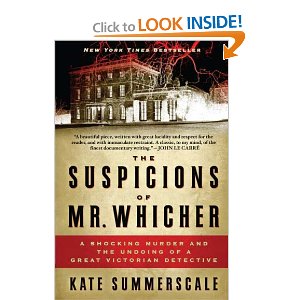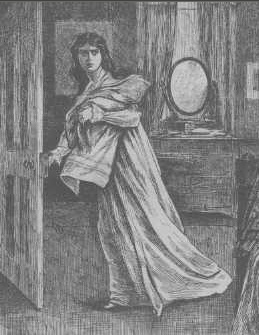 Summerscale, K. The Suspicions of Mr Whicher
Summerscale, K. The Suspicions of Mr Whicher
Nowadays the hideous murder of a child needs something special to get noticed–it has to occur at a midnight showing of a Batman™ movie, or involve Cheez Whiz™, or something™. Then it can grab our attention. Otherwise it’s just one of those awful but expectable things that happens sometimes, like a politician lying.
The world wasn’t actually more innocent in the 19th century–but it sometimes pretended it was (and that’s the essence of Victorianism, I guess). In 1860 a young boy was taken from his family’s English country house and brutally murdered, not necessarily in that order. The physical evidence immediately showed that someone inside the household must have killed the boy–that the murderer was possibly a member of his own family. The country was shocked… and fascinated.
Professional detectives had just been invented, and this was a story that attracted every amateur sleuthhound in the British isles. There were were sexual scandals and suppressed hatreds and dark secrets. This was a typical middle-class Victorian family, and other typical middle-class Victorian families seem to have spent a great deal of time cluck-clucking about how naughty they were. How very, very naughty.
The archetypal response to the crime may be the letter-to-the-editor written by a self-styled clergyman and magistrate, who supported a widespread theory that the family’s governess was complicit in the crime and had been having an affair with the father of the murdered child. Reverend Whatsisname recommended a physical examination of the governess to determine if she’d been screwing anyone. No doubt, in the interests of justice, he’d have been willing to perform the examination himself, or at least watch while it was done.
One of the reasons there was a mystery for the nation to discuss was that the investigation of the crime was botched from the beginning.
At sunrise (around 4 AM) on June 30, 1860, the governess of the Kent family got up and noticed that the family’s youngest boy, a beloved and perhaps somewhat spoiled three-year-old named Savill, was missing from his bed. She assumed that he was sleeping with his mother. When she went to get him for his morning bath, more than three hours later, it turned out he wasn’t with his mother–wasn’t anywhere in the house. Further, the drawing room door and one of its windows were unlocked and open.
Hysteria and searching ensued; the father reported his missing child to the police. Eventually the family gardener and a neighboring farmer (interested in earning the £10 reward posted by the father) discovered the boy’s dead body in an outdoor privy. The boy’s face was bruised, as if he’d been smothered; he had defensive wounds on his hands; he was stabbed in the heart; his throat was cut from ear to ear; he had been thrown down the privy hole, getting caught halfway down by something euphoniously called a “splash board”. Which I don’t know what that is and I don’t want to know.
It soon proved that the drawing room window could not have been opened from the outside. Someone inside the house had committed the crime.
Fortunately, crack police officer Superintendent John Foley was on the scene. The body of the murdered boy was kept in the house for a couple of nights until an inquest could be convened, and the house was full of suspects to the crime. So Foley assigned a couple of policemen to stay in the house. He put them at the disposal of Samuel Kent, the father of the family… who promptly locked them up in the kitchen. When a bloodstained shift or night-dress was discovered, possibly a clue, Foley ordered it returned to the hiding place where it had been found. He was evidently flustered because he thought the blood was menstrual blood. That is icky and biological and has no place in a serious business like a murder investigation, as I think we can all agree.
Foley’s crafty sleuthing led to the arrest and eventual trial of the family’s governess, Elizabeth Gough. It’s safe to say she was innocent of the crime. But it was widely believed that she was at least complicit in it–that Samuel Kent was having an affair with her, and that the dead child had witnessed “blissful proceedings” (in Dickens’ lip-licking phrase) and had been murdered to keep the secret.
It’s not as if it’s beyond belief that Samuel would have an affair with a governess. His then-wife was his second one; she had previously been the family’s governess, and their sexual relationship evidently began long before the death of the first Mrs. Kent.
But the eagerness of many to believe this particular scenario, on very incomplete evidence, shows something about the status of governesses in the Victorian families that could afford them. They were like the 19th century internet: intruders in the walls of the family home, come to inform and perhaps corrupt. Plus, they had actual vaginas. No wonder Reverend Whatsisname couldn’t stop thinking about them.
After Foley had been bungling things for a couple weeks an actual detective was sent down from the still-new detective division of the Metropolitan Police: Jonathan Whicher, widely considered the best investigator on the force. He rapidly came to a different conclusion than Foley: his suspicions focused on Savill’s much-older half-sister, Constance. The motivation was unclear; the evidence was thin to non-existent. But Whicher was convinced that Constance was the killer.
Gough was eventually brought to trial and acquitted. Constance was arrested, too, but was let go for lack of evidence.
The investigation ruined Whicher’s reputation and shook him up so badly that he presently retired from the police force.
Five years after the murder, Constance Kent voluntarily came forward and confessed to the crime. She had undergone a religious awakening, it seems, and wanted to atone for her crime. Her motive, she said, was revenge. Not against the dead boy but against his mother, Constance’s stepmother. Constance blamed her stepmother for stealing her mother’s place. Like Medea, she killed the child to hurt the parent. (One wonders if the governess-turned-stepmother came to regret a certain mythology lesson.)
Mystery solved. Disgraced detective vindicated. Everything back in place. Right?
No, not really. As Summerscale points out, Constance’s confession differs from the physical evidence in a number of specific and important particulars (starting with the cause of death). Summerscale theorizes that she edited her confession to exonerate someone else, possibly her brother William, who was complicit in the killing. Or she may have been protecting people who had helped her cover up the crime (which might explain some of her father’s odd behavior). Summerscale has a final speculation which displaces guilt for the crime in a different direction. I won’t ruin it by attempting a summary, but it seems plausible, and explains more of the odd deaths in this disturbed and disturbing family.
Whicher, at least, went on to become a fairly prominent private detective, uncovering the fraud of the Tichborne Claimant (which sounds like a Romney Pringle adventure).
This book is a superb work of narrative nonfiction: fastidiously researched, cleanly written, vividly detailed, emotional impactful, thoughtful and thought-provoking, full of interesting insights about the character of the times and the individuals in them. My only real complaint is that Summerscale sometimes displaces events from their chronological place in the narrative, so that (for instance) we only hear about the kitchen episode when Gough comes to trial. This can be somewhat bewildering, in a story when the events are already clouded by mystery. Still, it rarely happens and is a minor issue.
I especially enjoyed Summerscale’s attentiveness to the developing language of detection. Clue (or clew), for instance, was only starting to come into its modern meaning, from its older sense as “a ball of yarn”, and Summerscale charts some of the literary instances where the Ariadnean metaphor is still clearly in play.
It’s not just language she’s sensitive to. Her postscript comes to grip again with the beginning of the story, the body so easy to ignore in the wilderness of detection, the terrifying and brutal death of this little boy.
The book is only four years old, but is already a classic of the true crime and narrative nonfiction. It’s well worth reading.
And, unlike my previous “keep it or chuck it” book (and most of those to come), this review is not from a reread. I bought the book a couple years ago and never got around to it–a common enough event in the life of a bibliophile (or bibliomaniac).
Why is it even in the chuckable range?
Well: I don’t think I can stand to read it again, is the thing. Maybe I’ll feel differently in a year or two. But then I’m more likely to read Kate Summerscale’s next book, so…
This book is both highly recommended, for those who like this sort of thing, and to be chucked.
It’s got a few illegible marginal notations in it, where I argue with the book or someone in it, but other than that it’s a fairly clean copy. I’m willing to mail it to anyone who’ll front me the postage. (I’m not looking to make money off this, but I don’t want to lose any, either.) Drop me a line (I have a gmail account; the username is jamesenge) with WHICHER in the subject and I’ll get in touch with you.
On the other hand, I should add that you can probably get a pristine copy from Amazon. The used copies are like 1¢, plus postage, so…
If I don’t have any takers in a week or so I guess I’ll put it in the pile for Goodwill.
Claimed by Keith West.


